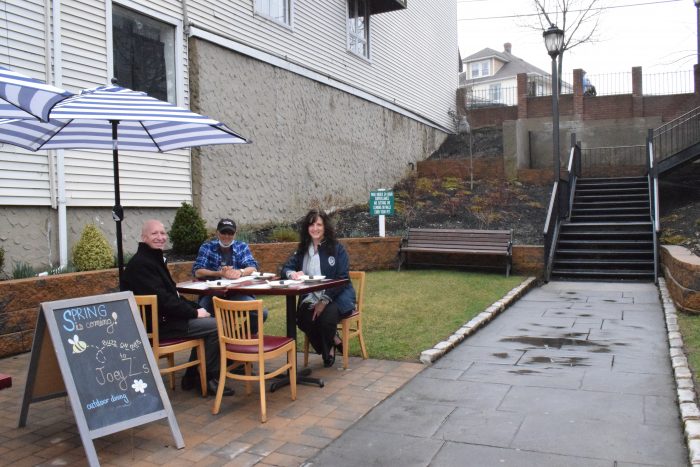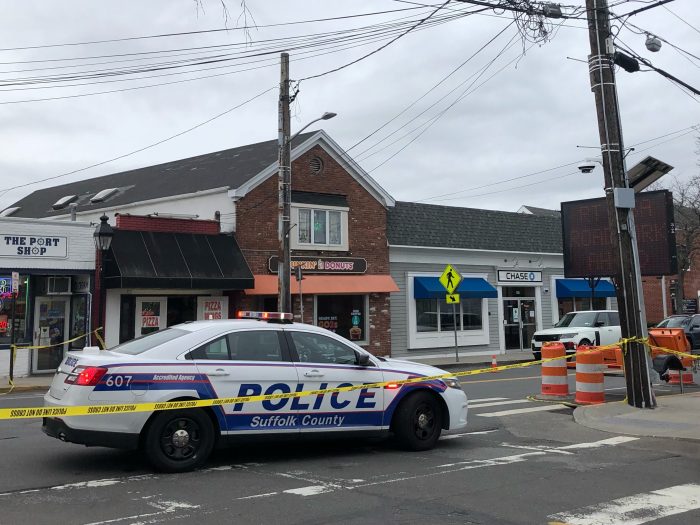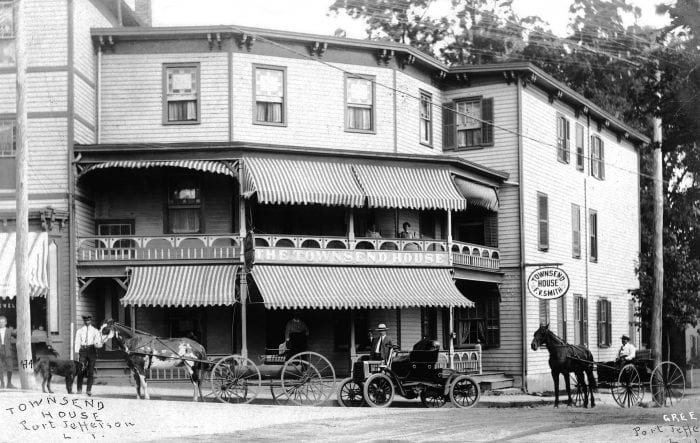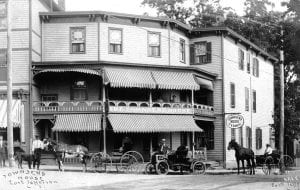It was a tragedy, but local officials say all the right protocols were in place which led to the quick arrest of a Port Jefferson Station man in the fatal shooting of 25-year-old David Bliss Jr. of Shirley.
The incident occurred on Wednesday, March 24, at approximately 3:35 p.m., when Bliss was shot in front of 122 Main St. in the village.
According to a Suffolk County Police Department spokesperson, police from the 6th Precinct were on the scene within 2 minutes, 32 seconds after the victim was hit.
Mayor Margot Garant said the whole incident itself took less than 10 seconds, from the argument between the two men to the duo in the car driving off.
“Upon learning of the incident, our code enforcement chief and I immediately headed to the scene,” she said.
But the police were already there, and once the SCPD steps in, they take the reins on any incident. Upon assessment, the police spokesperson said, the detectives on the scene immediately determined that it was a targeted incident.
“Upon arrival at the Port Jefferson shooting scene, police knew the shooter had left the area in a vehicle immediately following the shooting and a lockdown was not necessary,” the police said in a statement to TBR News Media. “Each incident presents specific circumstances that are assessed by responding personnel to determine if a lockdown is warranted and what radius needs to be covered.”
Village trustee Kathianne Snaden said that although some people are curious and are upset over the protocol, the village did everything within their ability to keep their residents and children safe.
“Everybody wants to know why a lockdown didn’t happen, and the last answer is we do not have that authority,” she said. “We confirmed that with our attorney and we don’t have that right.”
Garant reiterated the same, that although people may think the local government has more ability to shut down a village, they do not.
“As soon as Suffolk is on the scene, it is their game,” she said. “I do not have the authority to put the village in a lockdown situation. Under New York State law, I do not have that authority.”
Thanks to the village’s street cameras, police were able to get a license plate number and began tracking the vehicle which was already headed into Smithtown.
“The police officer on the scene confirmed the community is not in harm’s way,” Garant said. “He said they are tracking the vehicle in Stony Brook, heading to the Smithtown area and this is very much a one-on-one attack.”
And because investigators on the premise knew right away that the shooting was not a threat to the rest of the village, schools were not put on lockdown.
Snaden, who was watching her daughter’s tennis game at the school, got the call from Garant and immediately asked if a lockdown was needed.
“We can’t say it enough — as soon as the call came to me, my first question to the mayor was, ‘Are the kids safe?’” she said. “Margot was standing with Suffolk police who confirmed ‘yes.’”
Snaden, who is also the community liaison between the school district and the village government, began tracking down Port Jefferson Superintendent of Schools Jessica Schmettan who was already aware of the situation and rerouted the buses to avoid Main Street.
“Everybody was fully aware, and the school was already doing whatever protocol they do in these situations,” Snaden said. “Superintendent Schmettan had already, long before, already known about it and was acting on their behalf.”
Schmettan told the mayor that once she heard of the incident and bus reroutes, she communicated with the SCPD and verified that a lockdown was not needed — all within less than 10 minutes of the actual shooting.
Snaden said that upon learning of the incident, students were brought into the building out of an abundance of caution at the discretion of the athletic director and coaches who had kids outside.
“Upon notification of an emergency situation, our district immediately enacts our safety and security plans to help safeguard our schools,” Schmettan said in a statement.
“These plans have prescribed actions specific to various potential scenarios and are often guided by the unfolding details of the events transpiring. As the safety of our students and staff remain our top priority, we are thankful to our partners in law enforcement and our village officials for their continued partnership with regard to our safety efforts and for their open lines of communication along every step of the way.”
The next day
Garant said that the next day the village had a debriefing and decided to begin using their CodeRED system for situations like this.
Criticisms have been made that the village should have used the system to let residents know what happened, and Garant said normally CodeRED is used for villagewide emergencies, like natural disasters.
“If we had used CodeRED in this instance, because of the initial information and the lack of information from Suffolk at that point, the CodeRED would have just said that there is police activity on Main Street, please avoid the area, period,” Snaden said. “It wouldn’t have said lockdown.”
She added, again, the village does not have the authority to lockdown. Only the governor or county executive can make those decisions.
Garant said that the social media hysteria that happened along the way could have caused more harm than good.
“It’s dangerous, because what happened was parents rushed to the school, there could have been a traffic accident, there could have been who knows what,” Snaden added. “The rumors were extremely reckless.”
Some of the rumors claimed that a student from the Port Jefferson School District was the culprit, another was that it was an active drive-by shooter. Both of those claims ended up being false right away, but the threads kept going.
“It didn’t really matter what we did or didn’t do that day,” Garant said. “My job is to keep this community as safe as possible, and not create more chaos or danger to them.”
But Garant said she did have the executive decision to give the community statements on what was going on.
“This is because of who we are as government officials that we choose to do,” she said. “Because we feel it’s important. We’re not required to have this line of communication with the district.”
Garant added the CodeRED system currently has 4,800 subscribers and, after last week’s event, they will now use it more consistently.
“I think the thing that we learned from this is that we’re going to use our CodeRED and you need to be on our system,” she said. “You can get a text, you can get a voicemail, you can get an email. And that’s how you’re going to get alerted from us from this point forward.”
Catching the culprit
“The good news is because of their thorough investigation, they caught the shooter within 72 hours,” Garant said. “That’s exceptional.”
Snaden said the cameras that are throughout the village are state-of-the-art devices, which are hooked up to the Suffolk County Real Time Crime Center — the first village within the county do so.
When the code officer was on the scene, a doctor and nurse bystanders were already tending to the victim, as police headed over.
“There were good people that did help,” she said.
Snaden added that the village has 37 code officers, plus the chief, who monitor the area, and who work alongside the police. Two more hires are planned for this month.
“We have a good working relationship with the SCPD,” she said. “The code officer that was there was the supervisor at the time and secured the scene. He did what you are supposed to do as an officer.”
On March 27, SCPD arrested Joseph Garcia, 19, of 11 Market St., Port Jefferson Station, and charged him with 2nd degree murder.
He was arraigned on March 28 and pled not guilty.
The investigation is still ongoing and details about the altercation between the two men have not been released.
The SCPD encourages anyone with information about a crime to report it to 911 or anonymously to Crime Stoppers at 800-220-TIPS (8477).























